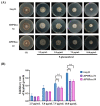Transcriptome and Quasi-Targeted Metabolome Analyze Overexpression of 4-Hydroxyphenylpyruvate Dioxygenase Alleviates Fungal Toxicity of 9-Phenanthrol in Magnaporthe oryzae
- PMID: 35806121
- PMCID: PMC9266922
- DOI: 10.3390/ijms23137116
Transcriptome and Quasi-Targeted Metabolome Analyze Overexpression of 4-Hydroxyphenylpyruvate Dioxygenase Alleviates Fungal Toxicity of 9-Phenanthrol in Magnaporthe oryzae
Abstract
Magnaporthe oryzae, the causal agent of rice blast disease, produces devastating damage to global rice production. It is urgent to explore novel strategies to overcome the losses caused by this disease. 9-phenanthrol is often used as a transient receptor potential melastatin 4 (TRPM4) channel inhibitor for animals, but we found its fungal toxicity to M. oryzae. Thus, we explored the antimicrobial mechanism through transcriptome and metabolome analyses. Moreover, we found that overexpression of a gene encoding 4-hydroxyphenylpyruvate dioxygenase involved in the tyrosine degradative pathway enhanced the tolerance of 9-phenanthrol in M. oryzae. Thus, our results highlight the potential fungal toxicity mechanism of 9-phenanthrol at metabolic and transcriptomic levels and identify a gene involving 9-phenanthrol alleviation. Importantly, our results demonstrate the novel mechanism of 9-phenanthrol on fungal toxicity that will provide new insights of 9-phenanthrol for application on other organisms.
Keywords: 4-hydroxyphenylpyruvate dioxygenase; 9-phenanthrol; Magnaporthe oryzae; overexpression; tyrosine degradative pathway.
Conflict of interest statement
The authors declare no conflict of interest.
Figures






References
-
- Liu W., Wang G. Plant Innate Immunity in Rice: A Defense against Pathogen Infection. Natl. Sci. Rev. 2016;3:295–308. doi: 10.1093/nsr/nww015. - DOI
-
- Islam M.T., Gupta D.R., Hossain A., Roy K.K., He X., Kabir M.R., Singh P.K., Khan M., Rahman A., Rahman M. Wheat Blast: A New Threat to Food Security. Phytopathol. Res. 2020;2:1–13. doi: 10.1186/s42483-020-00067-6. - DOI
MeSH terms
Substances
Supplementary concepts
Grants and funding
- 2018/Yunling Scholar Training Project
- 202101AU070101 and 202201AT070255/Basic Research Special Project in Yunnan
- GZKF2021003/Open research program of state key laboratory for consevation and utilization of Yunnan
- 2021ZDK003/Open Research Program of State Key Laboratory for Conservation and Utilization of Bio-Resource in Yunnan, Basic Research Special Project - General Project in Yunnan, Yunnan Key Laboratory of Green Prevention and Control of Agricultural Transboundary Pests
LinkOut - more resources
Full Text Sources
Research Materials

